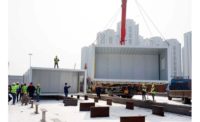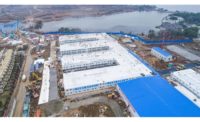Crews in Wuhan, China, wrapped up construction of two modular hospitals in less than two weeks, and both facilities have begun accepting patients infected with the novel coronavirus 2019-nCoV. But as the disease continues to spread, officials are now converting a growing list of facilities into makeshift hospitals.
Construction of the 1,000-bed Huoshenshan Hospital began Jan. 23 and finished on Feb. 2. The 33,900-sq-meter facility began accepting patients Feb. 4, local and state-run media reported. Work began on the 1,600-bed Leishenshan Hospital Jan. 25, and patients were admitted Feb. 8.
The two facilities were constructed at a cost of 300 million yuan ($43 million) by China Construction Third Engineering Bureau Co., a subsidiary of China State Construction Engineering Corp. (CSCEC). Progress was measured “in hours, not days” by adopting “cutting-edge prefabricated building technology that maximized the use of assembled industrial products and significantly reduced the workload of field operations,” according to a CSCEC statement.
At Houshenshan, the site’s height varied by as much as 10 m, which required movement of some 150,000 cu m of earth and relocation of high-pressure gas lines and other utilities. Only one main road led to the construction site, which made transport of materials, modular units and 1,000 large pieces of equipment difficult, a spokesman for the contractor told local media.
Next, the contractor had to quickly find and mobilize more than 1,000 project managers and 4,000 workers during a major holiday. When construction initially began, authorities reallocated 1,400 workers from five other construction projects in Wuhan to begin leveling the hospital site. Meanwhile, labor subcontracting companies quickly rounded up workers. For example, Fu Jianping, general manager of Hubei Hanzhang, a labor service company, took a bus around to several nearby rural areas and cities to pick up workers, according to local reports.
Procurement for the first hospital alone included thousands of modular box units, 14,000 cu m of concrete and 100,000 sq m of HDPE membrane, with supplies coming from different manufacturers depending on what was rapidly available, says the spokesperson.
The types of immediately available modular units and other materials impacted the design drawings, which were continually modified to incorporate the varying specifications. The hospital design included separate medical staff channels and patient channels to prevent cross infection. An isolation ward includes a transfer cabin with a UV disinfection system to enable delivery of food and medicine. To prevent contamination of surrounding environment, crews installed anti-seepage membranes and sewage treatment plants with multiple disinfectant steps.
Since many of the major project players are state-owned, the team could circumnavigate typical construction permitting and contractual roadblocks. For example, little to no contract negotiation was required among hundreds of suppliers and subcontractors. At the jobsite, tasks are organized and performed with military efficiency, according to local reports.
Fixed infrared temperature sensors in workers’ living quarters and on site keep an eye out for anyone who might be afflicted with the virus. CSCEC reports there were no safety incidents and no infections during construction.
China Construction Third Engineering Bureau is also renovating three existing multi-story outpatient facilities, with the first one delivered on Feb. 10, according to Construction Times, an independent construction publication in Shanghai. The three facilities add another 1,000 beds.
Wuhan officials have also converted several public spaces into temporary treatment centers and isolation wards for patients with mild symptoms. For example, a gym now houses 800 beds, while the Wuhan Convention and Exhibition Center holds 1,000 beds.






Post a comment to this article
Report Abusive Comment